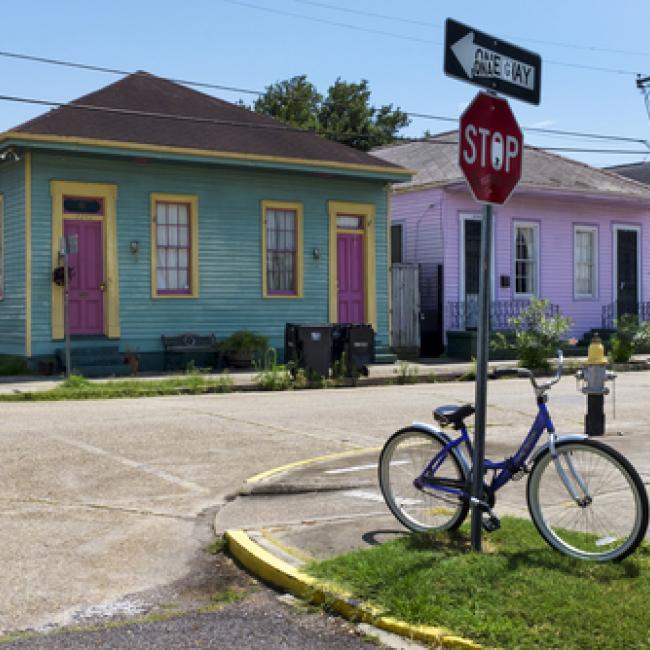Project Summary
The project team is examining the effectiveness of a neighborhood blight remediation strategy in New Orleans, Louisiana on Making Health A Shared Value drivers: well-being and health interconnectedness, sense of community and sense of safety, and civic engagement. They are also testing the causal relation between these drivers and family and youth violence, substance use, and mental health; as well as examining the moderating impact of additional neighborhood level buffers (e.g., fewer alcohol outlets, greater green and park space) on blight reduction efforts.
Research Questions/Aims
- What’s the impact and role of blight reduction on well-being and health interconnectedness, sense of community, sense of safety, and civic engagement?
- What’s the moderating impact of additional neighborhood level buffers (e.g., fewer alcohol outlets, greater green and park space) on blight reduction efforts?
Actionability
- Inform efforts to set the stage for changing mindsets and larger mobilization and action to build a Culture of Health and reduce inequities.
- Inform neighborhood place-based policy and prevention efforts in residential urban areas.
Results
Vacant lot remediation did not have a significant impact on 311 call volume, as theoretically purported. While there is a need for population-based, low cost, longitudinal methods for capturing community social capital and its components such as collective efficacy, municipal 311 data may not be the best marker of collective efficacy in a community. The nature of 311 calls and structural and historic factors at play in both the concentration of vacant properties in communities and residents’ willingness to call must be considered.
The blight remediation effort in New Orleans was associated with an increased incidence of domestic crime. However, the increases in domestic crime were lower in areas with a higher density of bars in which alcohol is consumed onsite (as opposed to liquor or convenience stores). Thus, place-based interventions to reduce blighted properties may have contributed to fewer domestic crime incidents in areas with more bars.
Place-based interventions have the potential to improve the health and safety of communities experience disadvantage. Examples from Philadelphia, PA; Flint, MI; Youngstown, OH; and New Orleans, LA suggest that interventions addressing vacant land and abandoned buildings reduce violence, the leading cause of death and disability in the U.S. Such interventions should be considered by community stakeholders, funders, and policy makers.
Outcomes
Health & well-being: Well-being (quality of life), health interconnectedness (perceived interconnectedness and social support for health), family and youth violence (intimate partner violence and child maltreatment), substance use, and mental health (psychological distress)
Other: Sense of community (collective efficacy and the sense of community), sense of safety (perceptions of safety and witnessing violence), and civic engagement (local voting rates and organizational participation)
Methodology
Community-level randomized controlled trial that randomly assigns clusters of lots within neighborhoods to intervention conditions that include lot greening and building/structure treatments. Lot greening consist of three phases: 1) a cleaning phase - removal of all refuse, debris and any overgrowth in designated lots; 2) a preparation phase – preparing soil and adding compost-rich topsoil, and obtaining seeds, trees, and fencing; a planting stage – planting grass, shrubs and trees and placement of a modest post-and-rail fence around the lot; and 3) a maintenance phase – bi-weekly mowing and cleaning during growing season. Building/structure treatments also consist of three phases: 1) a cleaning and preparation phase – removal of any trash or items on (e.g., porch) or around the structure, removal of broken or boarded windows, and preparation for painting; 2) a treatment phase – installing new windows and applying paint where applicable; and 3) a maintenance phase – bi-weekly checks during greening maintenance and replacement of any windows as necessary.
A cohort of approximately 400 residents will be followed for four waves of survey data collection, both pre- and post-treatment. Community conversations and focus groups with neighborhood residents, as well as key informant interviews with neighborhood leaders are conducted to gain qualitative information and an in-depth understanding of the role of blight and other community characteristics on outcomes.

- Tulane University School of Public Health and Tropical Medicine, Department of Global Community Health and Behavioral Sciences
- Institute of Women and Ethnic Studies
- Columbia University
- City of New Orleans Code Enforcement Division
- University of Pennsylvania
- Louisiana Public Health Institute, REACHnet
- Lower 9th Ward Neighborhood Empowerment Network Association
- Kaleb Hill, Oku Vue Produce Co.
- Tulane Prevention Research Center
- Preservation Resource Center of New Orleans
- Louisiana State Department of Health, Office of Public Health, Bureau of Family Health